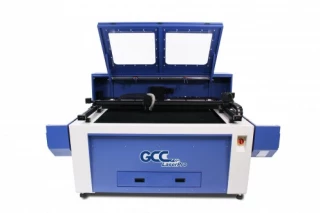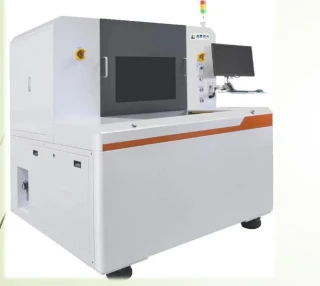Laser Cutters
Frequently Asked Questions
Laser cutting is a highly precise cutting technology that utilizes a focused laser beam to cut, drill, perforate and depanel various materials. Because of the localized nature of energy deposition through a focused laser beam, the cuts made by laser cutters are extremely precise. Add to this the CNC capabilities, and laser cutters become the most precise cutting machines on the market. Laser cutters generate very smooth edges and are capable of cutting various objects without damaging or warping the surrounding material.
Yes, most laser cutters come with integrated CNC capabilities allowing to program predefined shapes. Combined with precision laser beam steering technology this allows cutting very complex shapes and intricate details.
The primary drawback of laser cutters is their cost compared with competing technologies such as plasma cutting, waterjet cutting, mechanical cutting, sawing etc. That said laser cutting can actually be more economical on large volume projects requiring precision. The savings would come from lower maintenance costs, limited consumables and minimized scrap. Laser cutting will also require some training for expert operation of the machine even though most modern laser cutting machines are very user friendly.
The laser beam can be dangerous when coming into contact with skin or in case of a direct eye exposure. Most laser systems have safety features to mitigate this. Additionally, fumes created during laser cutting can be hazardous and care must be taken to extract them through a special fume extraction unit. The level of toxicity of the generated fumes will largely depend on the materials being cut.
The laser cutting process relies on the energy exerted onto the material by the laser beam. Depending on the wavelength of the laser beam in the laser cutting machine many materials including, wood, paper, cork, plastics metals can be cut by a laser cutter. With that said, not all materials can be cut with any laser cutter. The laser wavelength, output power, cutting speed, and repetition rate all play an important role on the capability and generated quality of a laser cutting machine.
The thickness of the cutting depends on what is being cut, i.e. the type of materials. Many laser cutters work in the range between 0.5mm to 15mm, and this will depend strongly on the laser parameters and the material properties.
Before selecting a laser cutter, you will need to carefully consider your application. What objects and materials are you going to cut? Is laser cutting the only process that you will use or would you also like to drill and engrave objects? Many laser cutters are multifunctional and you will want to select a unit that fits your applications. Additionally you will want to consider the work area, and laser specifications including the power, wavelength, repetition rate, as well as the CNC and integration capabilities. With all these parameters defined you will also want to consider your available budget and juxtapose this with other competing technologies.
Precision at Its Finest: Exploring the Capabilities of Laser Cutters
Laser cutting technology has revolutionized the way industries approach material processing. From intricate designs to industrial-scale fabrication, laser cutters offer unmatched precision, flexibility, and efficiency. As demand for accuracy and speed continues to grow, laser cutting has become an indispensable solution across a wide range of industries including aerospace, automotive, electronics, manufacturing, and even the arts.
At its core, a laser cutter works by focusing a high-powered laser beam onto a material surface, causing it to melt, burn, or vaporize along a defined path. This controlled interaction allows for exceptionally fine cuts with tight tolerances and smooth edges, even on complex geometries. Unlike mechanical cutting tools, laser cutters do not physically contact the material, which minimizes wear and tear, reduces contamination, and allows for the processing of delicate or intricate parts.
Laser cutters can handle a wide variety of materials with ease. Metals like stainless steel, aluminum, and titanium are commonly cut in industrial settings, while non-metals such as plastics, wood, acrylics, textiles, and glass are often processed for signage, prototyping, and consumer products. The versatility of laser cutting extends to thickness as well — from micrometer-thin films to sheets several centimeters thick, modern laser systems adapt seamlessly to different project requirements.
One of the standout features of laser cutters is their integration with computer-aided design (CAD) and manufacturing (CAM) software. This digital compatibility allows designers and engineers to translate complex digital drawings directly into cutting paths, increasing accuracy and reducing manual intervention. As a result, customization and small-batch production become economically feasible, opening the door for innovation in product design and rapid prototyping.
Another key advantage lies in speed and repeatability. Once a cutting pattern is programmed, the system can reproduce it across multiple units with identical results, reducing waste and enhancing productivity. Furthermore, modern laser cutters often incorporate automation features such as auto-focus, real-time monitoring, and multi-axis motion control, pushing performance even further.
From an operational standpoint, laser cutting is also relatively low-maintenance. Fiber and CO₂ laser sources boast long lifespans and require minimal upkeep, making them ideal for continuous operation. Compared to traditional cutting methods, laser systems offer a cleaner working environment, with minimal dust and fewer byproducts.
Sustainability is another consideration where laser cutting shines. The precision of the process leads to minimal material waste, and many laser cutters now feature energy-efficient components, reducing overall power consumption. As industries strive to meet environmental goals, laser cutting supports more sustainable manufacturing practices without compromising performance.
As laser cutting technology continues to evolve, we see increasing adoption in specialized applications — from micro-machining in electronics to artistic engraving and even surgical tool fabrication. With advancements in beam quality, control systems, and material compatibility, the scope of what’s possible with laser cutting continues to expand.
Whether you’re a manufacturer seeking efficient high-throughput solutions, a designer pushing creative boundaries, or a lab researcher requiring high-precision prototyping, laser cutters provide the power and precision to meet your goals. Explore the wide range of laser cutting systems available on FindLight to discover the right fit for your needs.


